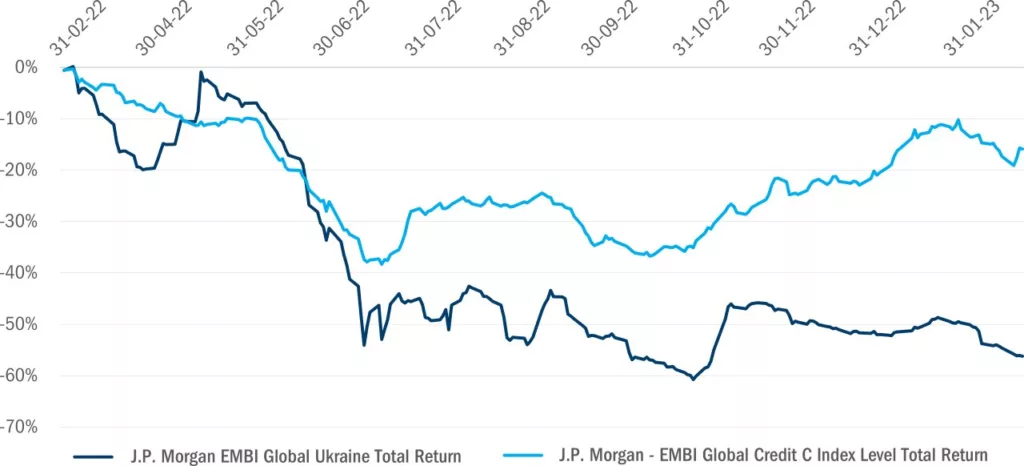- After 12 months of fighting further action is needed from the west to prevent a balance-of-payments crisis and to support the reconstruction costs faced by Ukraine
- With valuations trading close to the lows, what might a suite of restructured Eurobonds look like?
- Ukraine’s Eurobonds offer neither a clear asymmetry in the future return profile or a sufficient margin of error for upside assumptions to be wrong. Failing these criteria for investing in non-performing distressed credit, we find it hard to turn more constructive on the bonds
A year on from Russia’s invasion of Ukraine we are unfortunately no closer to seeing an end to the war than when the first bombs dropped on 24 February 2022. In the meantime, the Ukrainian economy has collapsed by a third, 20% of the population has left the country and immeasurable damage has been done to physical and human capital. While the west has stepped up to provide financial support, more will be required to prevent a full-blown balance of payments crisis: IMF estimates for 2023 external financing needs are as high as $57 billion2. Pressures on the currency persist and the central bank continues to lose an average of $500 million per week3 via FX interventions to support the new currency peg following the 20% devaluation last July. Given these uncertainties it is no mystery why Ukraine’s Eurobonds have materially lagged the rally in emerging market (EM) distressed debt since October.
Figure 1: total return of EMBIG Ukraine versus Global Credit C Index

We have supported Ukraine’s efforts to defer Eurobond debt service in the best interest of all stakeholders to ameliorate near-term economic damage and maximise future growth and recovery values4. The current standstill will expire in August 2024, prior to which sovereign bondholders will need to either extend the standstill or conclude a more sustainable debt restructuring. While bonds are already pricing in deep haircuts and deferrals, the lack of visibility around the duration of the war means further downside cannot be ruled out.
When we consider investing in distressed EM credit we try to answer two main questions: what is the upside/downside? And do current valuations offer a large enough cushion for us to be wrong in our assumptions about recovery values? Unlike in most sovereign restructuring cases there are massive uncertainties, including – at the extreme – whether the issuer will even exist as a sovereign entity in the medium term. Therefore, estimating the amount of debt Ukraine can reasonably afford to service and what a suite of restructured Eurobonds looks like is subject to multiple possibilities.
4Columbia Threadneedle Investments, Standstill on Ukraine debt is right for both the country and our clients, August 2022
5Columbia Threadneedle Investments analysis, February 2023
6https://www.president.gov.ua/en/news/ukrayina-stane-vzircem-vidbudovi-prezident-zvernuvsya-do-gen-79513

